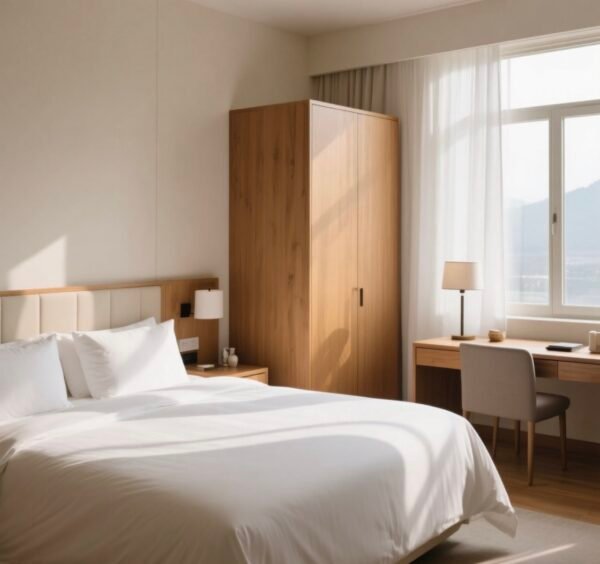“What Makes a Memorable Hotel Stay?”
Ask any hotel manager this question, and you’ll hear about fluffy pillows, attentive service, and gourmet breakfasts. But beneath these luxuries lies a basic expectation guests rarely verbalize:
Clean, hygienic furniture surfaces free from hidden microbial risks.
The Hidden Challenge
Hotel furniture – bedside tables, writing desks, armrests, wardrobe handles – endures constant contact from hundreds of guests each month. Even with daily cleaning:
- Bacteria such as Staphylococcus aureus and E. coli can linger on surfaces
- High humidity environments promote mold and fungal growth, especially on laminated woods or leatherette finishes
- Chemical cleaning agents degrade surface coatings over time, leading to dullness, discoloration, and structural weakening
🗣️ Expert Insight
“Furniture surfaces in hotels are high-touch, high-turnover zones. Antimicrobial treatments add a passive yet powerful layer of hygiene protection,” says Elaine Zhou, Senior Material Scientist at Hoteq Solutions.
Problem: Beyond Visible Cleanliness
Housekeeping staff maintain visual cleanliness, but microbial colonies are invisible. Studies show bacteria can survive on wood, laminate, and plastic surfaces for days, increasing cross-contamination risks among guests.
Solution: Antimicrobial Surface Treatments
✅ How Do They Work?
Antimicrobial agents such as silver, copper, and zinc compounds are integrated into furniture coatings or surface laminates. When microbes contact these treated surfaces:
- Metal ions disrupt cell membranes
- DNA replication is inhibited
- Microorganisms are destroyed, preventing proliferation
Silver-Based Coatings
Advantages:
- Effective at low concentrations
- Long-lasting, with minimal discoloration
- Ideal for luxury furniture requiring transparent or glossy finishes
Copper-Based Coatings
Advantages:
- Strong broad-spectrum antimicrobial activity
- Natural warm metallic tone suitable for rustic or industrial hotel designs
- Excellent antifungal properties for humid environments
Zinc-Based Coatings
Advantages:
- Safe and mild antimicrobial action
- Often combined with silver or copper for synergistic effects
- Cost-effective for large-scale furniture applications
Implementation Process
- Material Compatibility Assessment
Ensure base materials (wood, MDF, plastic laminates) can integrate metal-ion-based coatings without affecting structural or aesthetic qualities. - Formulation and Application
Antimicrobial agents are incorporated into polyurethane, acrylic, or melamine coatings during production and sprayed or rolled onto furniture surfaces. - Curing and Testing
Coatings undergo curing for hardness and durability, followed by antimicrobial efficacy tests based on ISO 22196 standards. - Quality Certification
Final products receive certifications for antimicrobial performance and safety compliance, supporting hotel procurement approvals.
🗣️ Hotel Manager Quote
“After adding antimicrobial surface treatments to our guest room desks and bedside tables, we noticed fewer maintenance calls about stains or odors. Guests even commented on how fresh everything felt,” shares David Tan, Operations Director at Sunview Hotel Group.
Benefits Beyond Hygiene
✅ Enhanced Surface Durability
Antimicrobial coatings protect against microbial degradation, preserving furniture aesthetics and structural integrity longer.
✅ Operational Cost Savings
Reduced cleaning chemical usage and extended furniture life lowers replacement and maintenance expenses.
✅ Brand Reputation Boost
Marketing antimicrobial-treated rooms appeals to health-conscious travelers, especially post-pandemic.
✅ Sustainability Alignment
Longer-lasting furniture reduces environmental impact from frequent replacements.
Challenges and Considerations
💰 Cost Implications
Premium antimicrobial coatings increase production costs by 10-20%, depending on agent type and coating thickness. However, ROI is realized through longer asset life and enhanced guest satisfaction.
🛠 Design Adaptations
Certain metal-based coatings can alter furniture tones. Collaborating with formulation experts ensures antimicrobial protection without compromising design intent.
📜 Regulatory Compliance
All additives must meet indoor air quality standards (e.g. VOC regulations) and be safe for human contact over prolonged exposure.
Future Trends
Hotels are exploring:
- Smart antimicrobial surfaces that change color upon microbial contact, signaling cleaning needs
- Nanotechnology-enhanced coatings maximizing efficacy while preserving ultra-thin finishes
- Integration with sustainability certifications, positioning hotels as leaders in safe and green hospitality
Final Thoughts
Clean sheets and courteous staff shape first impressions, but antimicrobial-treated furniture surfaces build trust guests never consciously question. They simply feel it – the confidence in touching, sitting, writing, and living within a hygienic, thoughtfully curated space.
✉️ Partner With Us
We provide silver, copper, and zinc-based antimicrobial solutions optimized for hotel furniture surface treatments. Contact our team to explore formulations that protect your assets and delight your guests.


-300x210.jpg)
